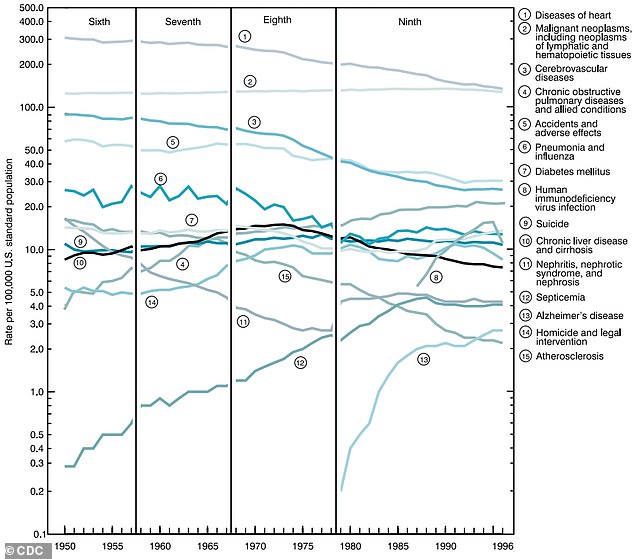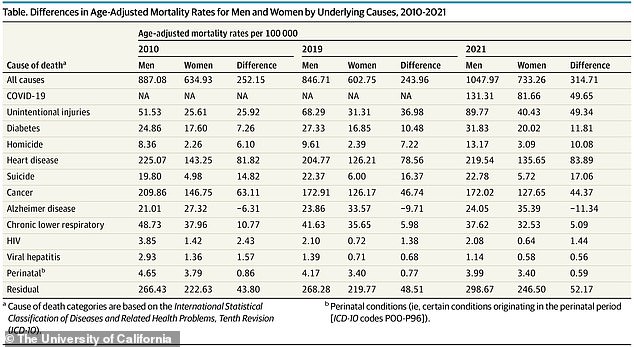Women are now living nearly 6 years longer than men in the US: New study reveals causes behind largest gender gap in life expectancy since 1996
>
A new study reveals the most significant U.S. gender gap in life expectancy since 1996.
A team of scientists led by the University of California, California, found that women now live 5.8 years longer than men, 0.2 years less than the record.
The most important contributor was… The Covid pandemic, which has had a disproportionate impact on men, followed Unintentional injuries, drug overdoses, accidents and suicide.
The team referred to the four cases as “deaths of despair” because they were linked to economic hardship, depression and stress.
A team of scientists led by the University of California found that women live 5.8 years longer than men. This is the largest gender gap in life expectancy since 1996
The UCLA-led team found that this gap is also due to improved medical care for women, such as lower rates of cancer and perinatal conditions.
“The varying increases in deaths from diabetes, heart disease, homicide and suicide suggest that chronic metabolic diseases and mental illness may also contribute,” the study published in the journal said. JAMA Internal Medicine.
“The increase in deaths from overdose, homicide and suicide underscores the twin crises of deaths of despair and gun violence.”
The analysis was conducted from March to July 2023 using mortality data from the National Center for Health Statistics.
The team aims to detect changes in the gap in life expectancy at birth between men and women from 2010 to 2021, divided by pre- and post-Covid-19 years.
“A lot of research has been done on declining life expectancy in recent years, but no one has systematically analyzed why the gap between men and women has widened since 2010,” said first author Brandon Yan.

A 1998 report from the Centers for Disease Control and Prevention shows a record 2,314,690 deaths in 1996 and 15 significant causes of death (pictured)

The largest contributor to the current gap has been the Covid pandemic, which has had a disproportionate impact on men. This was followed by unintentional injuries, poisonings (mostly drug overdoses), accidents and suicides, which the team called “deaths of despair.”
The data showed a huge increase in the gap since 2010, which was just 4.8 years.
A 1998 report from the Centers for Disease Control and Prevention showed a record 2,314,690 deaths in 1996 — 2,558 more than the previous record of 2,312,132 deaths set in 1995.
There were 15 leading causes of death at the time, the most prominent of which were heart disease, cancer and cerebrovascular disease, a group of conditions that affect blood flow and blood vessels in the brain.
Suicide ranked ninth on the list, while unintentional injuries, poisoning and accidents were not among the causes.
The new study determined that factors have since changed to those associated with economic hardship, depression and stress.
“While rates of drug overdose deaths and homicide have risen for both men and women, it is clear that men account for an increasingly disproportionate share of these deaths,” Yan said.
Data from the US Census Bureau also shows the impact Covid has had on men.
Between 2019 and 2020, male deaths increased by 296,061 (20.1 percent) and female deaths by 232,830 (16.9 percent). a report is reading.
This trend continued in 2021, with male deaths increasing by 68,208 (3.9 percent) and female deaths increasing by 12,298 (0.8 percent).
“The increasing difference in deaths between males and females in 2020 and 2021 suggests that the COVID-19 pandemic had a greater impact on male than female mortality.”
(Tags for translation) dailymail
